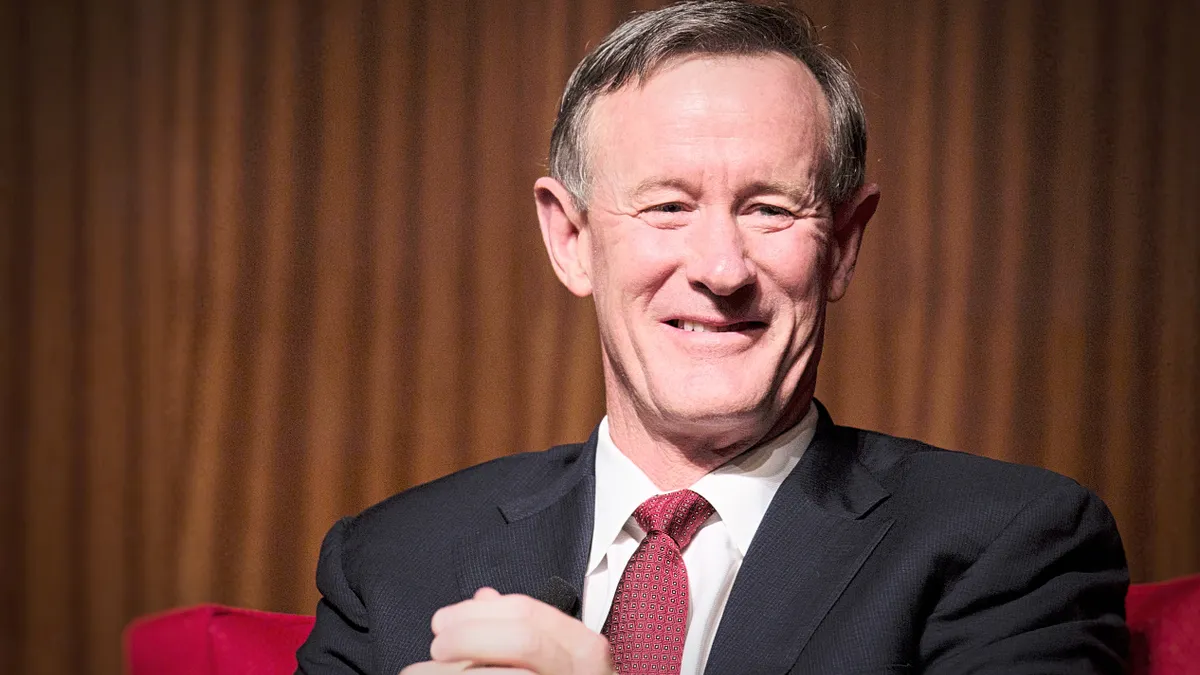University of Texas System Chancellor Bill McRaven may be best known outside of higher education circles for being the guy in charge during Operation Neptune Spear — or the raid which led to the death of Osama bin Laden. But today, the former Navy Admiral and Commander of the U.S. Special Operations Command is bringing this high level of strategic planning to the Ivory Tower.
For one, he stresses to a cadre of fairly new presidents in the UT System the importance of making “sure that when you transition that you adapt to the environment that you’re walking into; don’t ask the environment to adapt to you.”
One of the top priorities for McRaven is to build networks of people in the system who can collaborate and share information around common issues. Though he acknowledges the current system of weekly video conference calls with system leaders and "really, anyone who wants to join" is very demanding on the presidents' time, he sees them as an environment which can help drive innovation and solve problems within the network.
“This idea that the more people we include, both in the UT System and in collaboration with our partners, whoever they may be,” he said, adding that the “network has to include the healthcare professionals, the national labs, the think tanks — has to extend beyond our institutions.”
“The more we collaborate, the better we are,” he said.
“Why don’t we figure out ways that everybody can kind of share what the best practices are so we can all be world class,” asked McRaven, adding, “It’s not going to take away from the [individual] brand.”
But the challenge is “How do we pull people out of our silos and get them to collaborate more with the other institutions,” he said.
Breaking silos
“Historically, academic institutions and health institutions have been a little bit more siloed,” said McRaven. “They all kind of work within their community or their own discipline, so what we’re trying to do is get them to talk more to each other.”
“We’ve got to continue to get people out of their comfort zones a little bit, get them out of their silos, and be sure that they contribute to this environment of collaboration.”
All of the regional presidents and the administrators of the six health institutions in the system “are all having to deal with the same sorts of problems, so having this network really does help,” he said.
“We are all better the more diverse, the more networked we are,” he added.
University of Texas at San Antonio President Thomas Eighmy, who is only a few months into the job has bought in.
“I think the future of my institution and for San Antonio is this idea of ecosystems,” he said on a panel of UT Presidents at a recent “UT in DC” event designed to bring thought leadership from Austin around topics of defense and national security. I think the future of my institution and for San Antonio is this idea of ecosystems.”
“In the great city of San Antonio … we actually have 5 R&D enterprises,” he said. “It’s a very disruptive notional thing to think about all of that density of talent to be located within 10 miles of each other. So what do you do with that network?”
Eighmy said the system’s institutions are sometimes overshadowed by the flagship and other institutions in the state, but each of the universities has something to bring to the table, which comes out in a collaborative environment.
“The thing that I think is very limited for us right now and something that we as a system could challenge is this notion that the great challenges of today [don’t] require that you select UT Austin vs Texas A&M … what it really requires is … the very best people, and the very best people are at each of our institutions, they’re not just in one place,” he said.
“We as universities haven’t figured out how to pivot to working together to pull people from institutions A through Z, we haven’t figured out how to pivot out of our siloed selves to promote … these kinds of collaborations that were outside of the silos,” Eighmy continued. “Change happens and we’re prepared to move in a new world order, it’s just we’ve got to practice how to pivot.”
Another part of this, said UT Dallas President Richard Benson, is finding ways to position the research the institutions are producing as publicly accessible to help drive the conversation.
“I think we always have to be thinking about what we can do, frankly to change the world,” he said, adding “It behooves us to find ever greater ways of working in the national service.”
“We have an awful lot of latitude in each of our institutions, but in my time as president, we lean pretty heavily to the Penn State model” of research distribution, said Benson, who referred to what he calls a sort of “give it all away” model which collaborates closely with industry.
“I think you’re probably going to see more of that moving forward; I think more universities are probably going to travel that path, versus the other.”
McRaven said this path of making research and the fruits of the academic enterprise are critical.
“From cybersecurity to immigration policy to you name it, there’s someone in the University of Texas System doing it,” he said, urging policymakers and industry and those “especially in D.C. — let’s not just go to the Ivies [for expertise], come to UT too.”
















